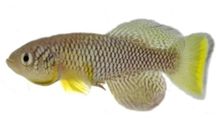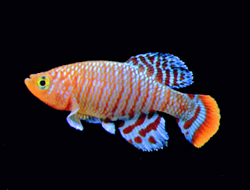
A killifish is any of various oviparous (egg-laying) cyprinodontiform fish, including families Aplocheilidae, Cyprinodontidae, Fundulidae, Profundulidae and Valenciidae. All together, there are 1,270 species of killifish, the biggest family being Rivulidae, containing more than 320 species. As an adaptation to living in ephemeral waters, the eggs of most killifish can survive periods of partial dehydration. Many of the species rely on such a diapause, since the eggs would not survive more than a few weeks if entirely submerged in water. The adults of some species, such as Kryptolebias marmoratus, can additionally survive out of the water for several weeks. Most killies are small fish, from 2.5 to 5 centimetres, with the largest species growing to just under 15 centimetres (6 in).

Nothobranchius is a genus of small, freshwater killifish, classified in the family Nothobranchiidae in the order Cyprinodontiformes. There are about a hundred species in the genus, many with very small distributions. They are primarily native to East Africa from Sudan to northern South Africa, whereas a dozen species are found in the upper Congo River Basin; the greatest species richness is in Tanzania.
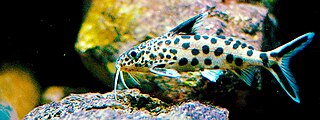
Synodontis multipunctatus, also known as the cuckoo catfish, cuckoo squeaker, or multipunk, is a small catfish from Lake Tanganyika, one of the lakes in the Great Rift Valley system in Africa. It is a brood parasite upon mouthbrooding cichlids. This species grows to a length of 27.5 centimetres (10.8 in) TL. This species is a minor component of local commercial fisheries.
Nothobranchius foerschi is a species of killifish in the family Nothobranchiidae. It is endemic to Tanzania. Its natural habitat is probably temporary pools. The specific name honours the German physician and aquaris Walter Foersch (1932-1993), who was an expert in killifish and was one of the first people to keep and breed this species.
The redtail notho is a species of killifish in the family Nothobranchiidae. It is endemic to Zanzibar. Its natural habitats are intermittent rivers and intermittent freshwater marshes. The redtail notho eats mosquito larvae and other planktonic creatures. Scientists are looking at introducing the species elsewhere in Africa to help with malaria prevention.
Nothobranchius jubbi is a species of killifish in the family Nothobranchiidae. It occurs in north eastern Africa in Kenya, Somalia and Ethiopia in temporary pools, ditches, marshes and rain pans, normally ones without any connections to rivers. This species was described in 1979 by Rudolf Hans Wildekamp and Heinz Otto Berkenkamp with the type locality given as a pool on the road to Garsen, 17 miles north of Malindi. The specific name honours the South African meteorologist and ichthyologist Reginald A. “Rex” Jubb (1905-1987) of the Freshwater Fish Section at the Albany Museum in Grahamstown, South Africa, in recognition of his taxonomic work on the genus Nothobranchius.

Nothobranchius korthausae is a species of killifish in the family Nothobranchiidae. It is endemic to Mafia Island in Tanzania. Its natural habitat is pools, ditches and small streams. The specific name of this species honours the German aquarist Edith Korthaus who collected the type.
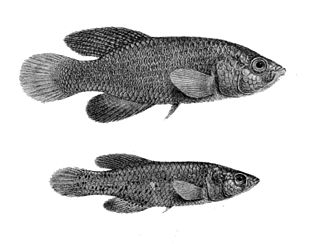
The spotted killifish is a small, short lived species of fish, an African rivuline from the family Nothobranchiidae. These fish are native to many isolated freshwater pools located in the savannah depressions of east Africa, specifically Malawi, Mozambique, Zimbabwe, and South Africa. This species of fish occurs in ephemeral waters and killifish eggs can survive long periods of dehydration. The word killifish likely comes from the Dutch kil for kill.
Nothobranchius kafuensis, known as the Caprivi killifish or Kafue killifish, is a species of killifish in the family Nothobranchiidae. This killifish is found in temporary pools, swamps and ditches in the floodplains of the Kafue and Upper Zambezi rivers in western Zambia and the Caprivi Strip in Namibia.
Nothobranchius steinforti is a species of killifish in the family Nothobranchiidae. It is endemic to Upper Wami River drainage, Tanzania. Its natural habitat is intermittent freshwater marshes, pools and rice fields. This species was described in 1977 by Rudolf Hans Wildekamp with the type locality given as "8 kilometers from Kimamba, Tanzania". The specific name honours the Dutch aquarist Theo Steinfort who helped collect the type and bred this species in captivity, making it available to other killifish hobbyists.

Nothobranchiidae are a family of bony fishes containing roughly 300 species, also known as African rivulines. They are small killifish, usually measuring about 5 centimetres (2.0 in). They are limited to Africa, living in fresh water but being also somewhat salt-tolerant. They are also found in muddy or brackish water. Some species are kept as aquarium pets. They have frilly fins and many are brightly colored. They were formerly included in the family Aplocheilidae ; a return to that broader family has recently been suggested.

The Max Planck Institute (MPI) for Biology of Ageing, founded in 2008, is one of over 80 independent, non-profit-making institutes set up under the umbrella of the Max Planck Society. The overall research aim is to obtain fundamental insights into the aging process and thus to pave the way towards healthier aging in humans. An international research team drawn from almost 30 nations is working to uncover underlying molecular, physiological and evolutionary mechanisms.
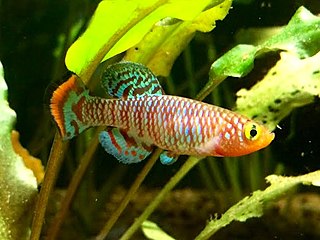
Nothobranchius rachovii, the bluefin notho, is a species of freshwater annual killifish from Mozambique. It can grow up to 6 cm (2.4"). It is popular among killifish enthusiasts, who raise them from eggs in aquaria.
In biogeography, geodispersal is the erosion of barriers to gene flow and biological dispersal. Geodispersal differs from vicariance, which reduces gene flow through the creation of geographic barriers. In geodispersal, the geographical ranges of individual taxa, or of whole biotas, are merged by erosion of a physical barrier to gene flow or dispersal. Multiple related geodispersal and vicariance events can be mutually responsible for differences among populations. As these geographic barriers break down, organisms of the secluded ecosystems can interact, allowing gene flow between previously separated species, creating more biological variation within a region.
Nothobranchius ditte is a species of brightly colored seasonal killifish in the family Nothobranchiidae, belonging to the Nothobranchius brieni species complex. It is endemic to freshwater habitats in the south-eastern parts of the Democratic Republic of the Congo. Adult males reach a length of about 40–42 mm, but the females are slightly smaller. The species is a semi-annual killifish. They inhabit ephemeral pools filled by rainwater during the monsoon season, being adapted to the alteration of dry and wet seasons. As with all members of the genus Nothobranchius, they show extreme life-history adaptations: their embryos survive by entering a three or four month long diapause, within eggs that have a very hard chorion and are resistant to desiccation and hypoxia. When the habitats dry up, the adult fish die and the eggs survive encased in the clay during the dry season.

The mitochondrial theory of ageing has two varieties: free radical and non-free radical. The first is one of the variants of the free radical theory of ageing. It was formulated by J. Miquel and colleagues in 1980 and was developed in the works of Linnane and coworkers (1989). The second was proposed by A. N. Lobachev in 1978.
Nothobranchius sainthousei is a species of brightly red- and blue colored seasonal killifish in the family Nothobranchiidae. It is endemic to freshwater habitats in the Chembe district of the Luapula Province in northern Zambia. It was named in honour of Ian Sainthouse, a "renowned breeder and collector of killifish, for his special longstanding dedication to researches on the genus Nothobranchius".
Béla Nagy, a Hungarian independent researcher, specialized in the seasonal killifish genus Nothobranchius, as well as members of the family Procatopodidae within the order Cyprinodontiformes.
Nothobranchius albertinensis is a species of brightly colored seasonal killifish in the family Nothobranchiidae. This species is endemic to seasonal freshwater habitats in north-western Uganda. It is currently known from ephemeral pools and marshes associated with the Albert Nile drainage, as well as small river systems draining into the north-eastern part of Lake Albert.
Nothobranchius attenboroughi is a species of brightly colored seasonal killifish in the family Nothobranchiidae. It is endemic to Tanzania. It is currently known from ephemeral pools and marshes associated with the Grumeti River and other small systems draining into Lake Victoria at the east side of the lake, which ecological integrity is maintained by the congruence of its catchments largely within the Serengeti-Mara ecosystem.
